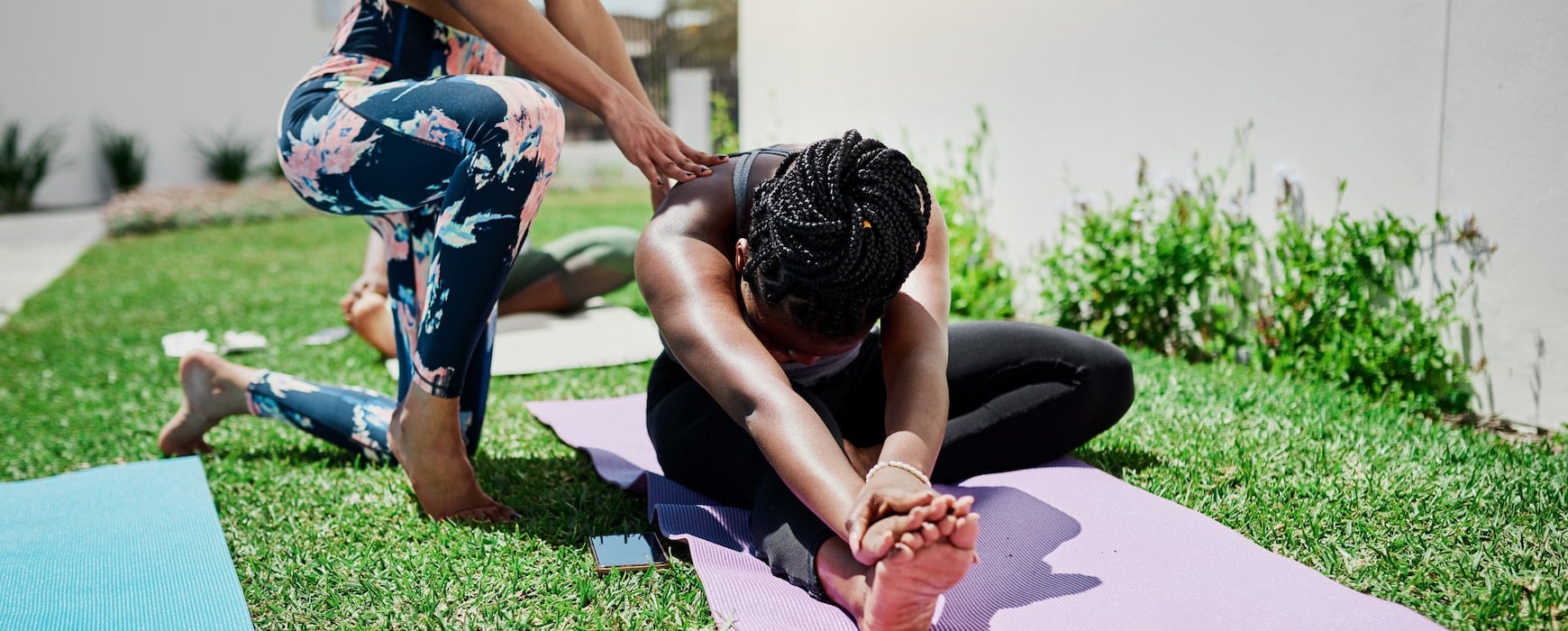Professional yoga instructors aim to safely guide students of all ages and abilities on a journey toward greater strength, flexibility and mindfulness, both on and off the mat. A student looking to spread the good vibes may want to learn how to become a yoga teacher.
Feeling inspired to lead a group of people through sun salutations? Review these 10 steps for how to become a certified yoga instructor.
Become a yoga instructor in 10 steps
Whether you’re a lifelong yogi or still mastering the downward-facing dog, these steps can help guide you on the path to becoming a yoga instructor.
1. Be clear on your intentions
First, ask yourself why you want to become a yoga instructor. Do you want to inspire others spiritually? Help them to achieve physical fitness goals? Promote a more holistic way of living? Your answer(s) to this question will help you set the direction for the kind of yoga teacher you want to be.
2. Decide on your yoga style
There are many different types of yoga you can teach and practice. To decide which one(s) you’re interested in, consider the traits of different forms of yoga.
For example, do you like the athleticism of Vinyasa yoga? The spiritual aspect of Kundalini yoga? The heat and sweat of Bikram yoga? Or the healing and calming nature of restorative yoga? While some teachers may train in a variety of yoga traditions, choosing one will help narrow your focus — especially as a new teacher.
3. Research and complete your training
While you don’t technically need a license for teaching yoga, most studios and clients expect teachers to be Registered Yoga Teachers (RYTs) with Yoga Alliance.1
To apply as an RYT, you’ll need to complete at least a 200-hour training course with a Registered Yoga School (RYS).
If you want to take your training further, you can pursue 300 or 500 hours of training. (Think of it as earning a master’s degree in yoga.) There are dozens of additional training and specialization modules you can take if you want to teach prenatal yoga, yoga for rehabilitating injuries, or any other niche practice.
Here are several options for finding an RYS:
- Browse local studios in your area, many of which likely offer programs that last from a few months to a year.
- Find an online teacher training program that fits your schedule.
- Travel for an intensive program that allows you to complete yoga certification in 10 days to a month.
Before you choose a training program, research the teachers leading it. If you reach out, most studios will talk to you about their syllabus. It’s also important to consider the tradition and lineage of prospective training programs.
Once you’ve found a yoga instructor certification program that fits your schedule and meets your goals, you’re well on your way to becoming a yoga teacher!
4. Budget for the training
Depending on the type and length of training you’re interested in, you can expect to spend between $1,000 to $10,000 or more on a certified teacher training program and materials.
You may be able to save money on your training by signing up for “early bird” training pricing or becoming a Yoga Alliance member. Some training programs offer scholarships to help students afford tuition. Additionally, some studios may trade tuition for time spent volunteering to work at the studio.
5. Sequence a schedule that works for you
Now that you’ve budgeted your financial resources, it’s time to think about budgeting your time. If you’re doing a 200-hour program, you can knock it out in a month — if you dedicate 100% of your time to it.
If you’re working full-time, have young kids or have other pressing responsibilities, you may need to stretch your training over a few months or a year. Fortunately, many programs are self-guided and allow students to complete them at an individualized pace.
6. Get a CPR certification
All yoga teachers should have a CPR (cardiopulmonary resuscitation) certification. People who complete a CPR certification will know the causes and early warning signs of cardiac arrest and other health problems that could manifest in the yoga studio.
Understanding these situations and knowing how to respond to them is critical for any yoga teacher who wants to keep their students safe and healthy. Look for CPR certification programs in your area, or contact your teacher training program director for certification recommendations.
7. Prepare to teach your first classes
Your yoga teacher certification program will likely provide you the opportunity to teach classes. You’ll want a lot of experience before you start teaching professionally because you must learn to cue poses for students with varied experience, offer injury modifications, and tailor private classes.
Try out the following:
- Teach your friends and family. If they’re complete beginners, that’s even better! You’ll have the opportunity to ensure your instruction is crystal-clear.
- Teach by-donation. Everyone loves a free class. Try offering a single class or a month-long themed series on Zoom or YouTube, out of your living room, or at the studio where you train.
Once you’re ready to teach, contact local studios to set up demo classes as an audition. You might begin as a substitute teacher and work up to leading your own regular class.
8. Make sure your business is legal
While yoga is loosely regulated, income from yoga teaching is another matter. You’ll need to report all income from your instruction on your tax returns. If you’re teaching at a studio, they may give you a 1099 form at the end of the year. If you’re personally taking payment, carefully record all income, whether it’s via cash, check, app, online transfer or any other platform.
While you can add 1099 and freelance income to your regular tax return, some yoga teachers create limited liability corporations (LLCs) to keep better track of their business. Once you’ve formed an LLC, you can open a separate business bank account for your income from yoga. Now that you’ve had some experience leading classes and setting up your business, it’s time to grow!
9. Market and grow your business
Yoga studios usually pay a base salary per hour with additional income for each student after a specific class size. As you get experience teaching group classes, you’ll grow your class size and start to connect with individual clients who may be willing to pay a higher price for private sessions.
Your location, experience and reputation can impact how much you can make as a yoga teacher. Take these steps to market and grow your business:
- Create a website. As you create traction for your yoga business, people will want to find you online. That’s why it’s essential to have a website. If the prospect of creating one is daunting, know that there are many free website builders available that have preset templates for you to use.
- Set up your online profiles. You better believe your pupils will look you up on social media! If you already have a personal account on Instagram or Facebook, consider leveraging your following to follow your new “professional” profiles.
10. Protect your business
We know yoga is all about peace and calm, but a lot could go wrong. For example, should a client claim your hands-on adjustment led to neck pain, they could sue you for bodily injury and the cost of their physical therapy. That’s why you need insurance.
When you get your first studio teaching job, the manager may ask you to buy general liability insurance. Even though yoga studios have insurance, coverage might not extend to teachers. This is even more important if you’re not teaching in a studio. You take on significant liability when teaching yoga classes in your home, online or at a rental space.
Thimble’s Yoga Teacher Insurance protects you from the financial impact of third-party bodily injury, property damage, and personal and advertising injury.
Fast and flexible, Yoga Teacher Insurance is available by the job, month or year so you get coverage exactly when you need it. Monthly policies have optional Business Equipment Protection, which protects your yoga equipment as you travel between gyms and studios. Click “Get a Quote” or download the Thimble mobile app. Answer a quick set of questions, and you’ll be covered faster than you can flip to up-dog.
Source:








